I am washing my hands and praying like crazy I won't catch it from him.
Thankfully our next door neighbor took his snow blower to our driveway about five minutes before I suited up to tackle it this morning.

After yesterday's post about needle snowflakes, I had been checking outside to see the snowflakes and only about an hour ago did the flakes take on any interesting shapes.
Using the chart...this would be called a Stellar Plate.
The dotted lines around the flake is the frozen moisture residue from when I wiped down the magnifying camera lens before putting it outside to capture flakes.
What a difference my new 60mm lens makes in snowflake photography.
From the snowflake identification website:
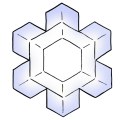 Stellar
Plates Stellar
PlatesThese common snowflakes are thin, plate-like crystals with six broad arms that form a star-like shape. Their faces are often decorated with amazingly elaborate and symmetrical markings. |
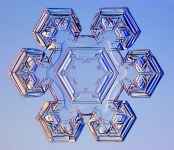 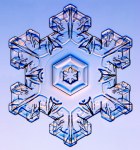 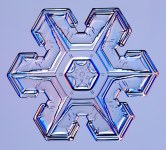 Plate-like snowflakes form when
the temperature is near -2 C (28 F) or near -15 C (5 F), as dictated by the snow
crystal morphology diagram. Plate-like snowflakes form when
the temperature is near -2 C (28 F) or near -15 C (5 F), as dictated by the snow
crystal morphology diagram. |
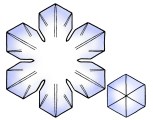 Sectored
Plates Sectored
PlatesStellar plates often show distinctive ridges that point to the corners between adjacent prism facets. When these ridges are especially prominent, the crystals are called sectored plates. |
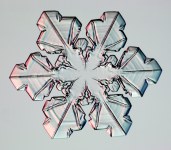 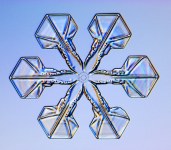 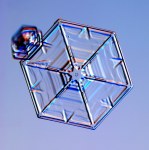 The simplest sectored plates are
hexagonal crystals that are divided into six equal pieces, like the slices of a
hexagonal pie. More complex specimens show prominent ridges on broad, flat
branches. The simplest sectored plates are
hexagonal crystals that are divided into six equal pieces, like the slices of a
hexagonal pie. More complex specimens show prominent ridges on broad, flat
branches. |

This one has the side branches on its branches so it is a simple stellar dendrite.
|
|
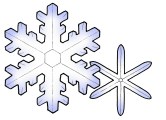 Stellar
Dendrites Stellar
DendritesDendritic means "tree-like", so stellar dendrites are plate-like snow crystals that have branches and sidebranches. These are fairly large crystals, typically 2-4 mm in diameter, that are easily seen with the naked eye. |
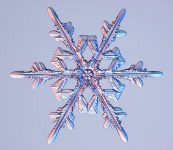 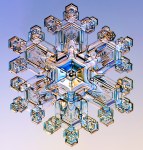 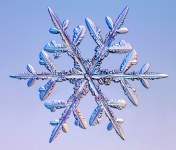 Stellar dendrites are clearly the
most popular snow crystal type, seen in holiday decorations everywhere. You can
see these crystals for yourself quite well with just a simple magnifier. (See
Snowflake
Watching for more about observing snowflakes.) Stellar dendrites are clearly the
most popular snow crystal type, seen in holiday decorations everywhere. You can
see these crystals for yourself quite well with just a simple magnifier. (See
Snowflake
Watching for more about observing snowflakes.) |

This, of course, is a Snoopervising Faithful Orange Cat keeping me company as I work.
I had set the lens outside to gather snowflakes; when I went to go check on the flakes moments later I found him sitting with his fluffy belly directly over the lens.
He tries to help, he really does.

I can see a plate or two here too.
Having a heart beat while focusing makes the different between blur and clear.
My slow heart beat works in my favor; the beats are stronger as they pump out more blood and I get a stronger shake because of that fact.
Eventually I will tripod to elimate this issue.
Just not today.

Thinking this one is a Sectored Plate?

It amazes me that a shift in temperature by a degree or two will create completely different snowflake structures.
I am also glad that it works like that.
Makes having snowfall so much more interesting.

The weathervane across the street...will this storm eventually bury the letters?
It is getting close.
All for now...





10 comments:
I am so amazed by all your snowflake photography! I never imagined a snowflake to be so detailed and intricate, and then to have them all classified and named... and then to get such marvelous photos of them! Wow! Fascinating!
Your cat is gorgeous, and I loved his efforts to "help". :)
Jill - this is fascinating!!! Stay well and keep the beautiful pictures coming - so inspiring!
It really is so interesting. Even the swipes you made are interesting. Can't help but think what beautiful jewelry could be created from these exquisite forms. So sorry that Bernie is still under the weather. I know that you're taking good care of him and getting out in the fresh air has got to be good for you.
Wow....Jill..that 60mm really does do amazing work. I can imagine you hunting all around with your camera lens and this is only the first few days in January. Just imagine what each new season will bring you to capture.
OH..and keep washing your hands...good Jill!
Lovely shots and interesting information. I do hope you avoid the flu...
We certainly are learning a lot about snow here on your blog lately; it's all rather fascinating. I notice you even have Ellen photographing ice needles and icicles in Washington too. Your new lens is working wonders.
Yes...very good! And you've taught us a lot about snowflakes with your 60mm.
Stay well! Have you had flu shots over there?
These shots about snowflakes you've been posting are completely fascinating. In an overwhelming way. It's hard to believe all of the differences.
Ditto to all the comments about the snowflakes photography being so interesting! I had no idea they really are that detailed and beautiful.
Your cat looks very much like mine. However, mine wouldn't know the first thing to do if she was outside in a snow storm! She's an indoor kitty who has to imagine what it's like out there!
Post a Comment